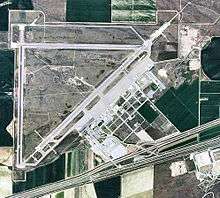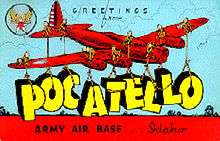Pocatello Regional Airport
Pocatello Regional Airport (IATA: PIH[2], ICAO: KPIH[3], FAA LID: PIH) is a city-owned, public-use airport located seven nautical miles (13 km) northwest of the central business district of Pocatello, a city in Bannock County, Idaho, United States.[1]
Pocatello Regional Airport (formerly Pocatello Army Airfield) | |||||||||||||||
|---|---|---|---|---|---|---|---|---|---|---|---|---|---|---|---|
 USGS 2006 orthophoto | |||||||||||||||
| Summary | |||||||||||||||
| Airport type | Public | ||||||||||||||
| Owner | City of Pocatello | ||||||||||||||
| Serves | Pocatello, Idaho | ||||||||||||||
| Elevation AMSL | 4,452 ft / 1,357 m | ||||||||||||||
| Coordinates | 42°54′35″N 112°35′45″W | ||||||||||||||
| Website | www | ||||||||||||||
| Map | |||||||||||||||
 PIH Location of airport in Idaho / United States  PIH PIH (the United States) | |||||||||||||||
| Runways | |||||||||||||||
| |||||||||||||||
| Statistics (2018) | |||||||||||||||
| |||||||||||||||
The airport is built on the site of the Pocatello Army Airfield, a World War II training base. Many of the base facilities have been razed, although four large hangars remain. The airport is also the home to the National Weather Service Pocatello Office.
As per the Federal Aviation Administration, this airport had 25,756 passenger boardings (enplanements) in calendar year 2008, 21,039 in 2009, and 20,825 in 2010. The National Plan of Integrated Airport Systems for 2011–2015 categorized it as a primary commercial service airport.
The airport is home to the Kizuna Garden, built to commemorate the bond between Pocatello and its sister city Iwamizawa.[4]
Facilities and aircraft
Pocatello Regional Airport covers an area of 3,374 acres (1,365 ha) at an elevation of 4,452 feet (1,357 m) above mean sea level. It has two runways with asphalt surfaces: 3/21 is 9,060 by 150 feet (2,761 x 46 m) and 17/35 is 7,150 by 100 feet (2,179 x 30 m).[1]
For the 12-month period ending January 1, 2012, the airport had 36,764 aircraft operations, an average of 100 per day: 79% general aviation, 20% air taxi, 1% military, and <1% scheduled commercial. At that time there were 73 aircraft based at this airport: 70% single-engine, 22% multi-engine, 7% helicopter, and 1% jet.[1]
Airline and destination
Passenger
| Airlines | Destinations |
|---|---|
| Delta Connection | Salt Lake City |
Statistics
| Carrier | Passengers (arriving and departing) |
|---|---|
| SkyWest | 87,760(100%) |
| Rank | Airport | Passengers | Airline |
|---|---|---|---|
| 1 | Salt Lake City International (SLC) | 44,000 | Delta Connection |
History

In 1943, the Pocatello Army Airfield was built as a Second Air Force heavy bomber (B-17, B-24) training base.
In 1949, it became surplus property and was obtained by the city of Pocatello to build a commercial airport.
Western Air Lines served Pocatello for a number of years, but discontinued all service by 1980.[6] According to the airline's August 1, 1968 system timetable, Western operated Lockheed L-188 Electra turboprops into Pocatello. This Electra service was then replaced with Boeing 737-200 jetliner service with nonstop flights to Salt Lake City, and direct flights to Las Vegas and Los Angeles, according to the airline's September 6, 1973 system timetable. After discontinuing mainline flights, the airline subsequently served the airport as Western Express which was operated as code share service by SkyWest with commuter turboprop aircraft.[7]
In the mid 1970s, Hughes Airwest served the airport with Douglas DC-9-10 and DC-9-30 jetliners, according to the February 1, 1976 edition of the North American Official Airline Guide.
In the mid 1980s, Cascade Airways served Pocatello with British Aircraft Corporation BAC One-Eleven twin jets, according to the February 15, 1985 edition of the North American Official Airline Guide (OAG). The OAG also lists Cascade flights operated with smaller Fairchild Metro commuter turboprops.
Horizon Air served Pocatello until January 7, 2006, originally with service to Salt Lake City in 1983. The airline canceled that service in favor of flights to Boise starting in 1984 operated with de Havilland Canada DHC-8 Dash 8 turboprops.[8]
Big Sky Airlines served Pocatello from the day Horizon canceled service until March 30, 2007.[9][10][11]
In 2014, a World War II-era mortar was found on the airport grounds while doing routine maintenance work. The mortar was safely removed by law enforcement.[12][13]
References
- FAA Airport Master Record for PIH (Form 5010 PDF). Federal Aviation Administration. Effective February 4, 2017.
- "IATA Airport Code Search (PIH: Pocatello)". International Air Transport Association. Retrieved June 12, 2014.
- "Airport information for PIH (KPIH)". Federal Aviation Administration. Retrieved June 12, 2014.
- "Kizuna Japanese Garden at the Pocatello Regional Airport - Pocatello.net". Pocatello.net. 2017-06-02. Retrieved 2017-08-13.
- "Pocatello, ID: Pocatello Regional (PIH)". Bureau of Transportation Statistics (BTS), Research and Innovative Technology Administration (RITA), U.S. Department of Transportation. December 2013. Retrieved February 17, 2017.
- Western Airlines: Historic Route Maps and Timetables
- 1987 Western Airlines: Route Map
- "Horizon to Add Flight Tying Boise, Pocatello". Eugene Register-Guard. March 25, 1984.
- "Pocatello hoping to keep Big Sky Airlines at airport". Deseret News. The Associated Press. January 22, 2007.
- "OST-2005-23101 - Horizon Air - Intent to Discontinue Service Between Pocatello-Boise, Idaho". Airline Information Research. Archived from the original on April 25, 2012.
- "Pocatello loses airport manager, airline". Idaho Business Review. March 26, 2007.
- "Airport workers find WWII device". Local News 8. April 15, 2014.
- "WWII explosive device found at Pocatello Regional Airport". Idaho State Journal. April 15, 2014.

External links
- Official website

- Pocatello AvCenter, the fixed-base operator
- Aerial image as of June 1992 from USGS The National Map
- FAA Airport Diagram (PDF), effective July 16, 2020
- FAA Terminal Procedures for PIH, effective July 16, 2020
- Resources for this airport:
- AirNav airport information for KPIH
- ASN accident history for PIH
- FlightAware airport information and live flight tracker
- NOAA/NWS weather observations: current, past three days
- SkyVector aeronautical chart for KPIH
- FAA current PIH delay information
